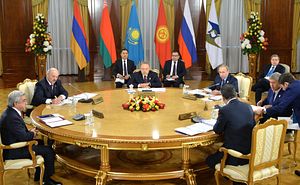On Tuesday, the leaders of the Eurasian Economic Union converged on Astana for high-level talks. The presidents of Russia, Kazakhstan, Belarus, Armenia and Kyrgyzstan held narrow format talks which had integration of the EEU and China’s One Belt, One Road high on the agenda. Meanwhile, a conference in Moscow on China-Russia relations also circled the issue of Eurasian integration.
The EEU–formally 17 months old–remains a confounding and troubled organization. Envisioned as an economic union and a single integrated market, the constituent countries remain sometimes at odds and observers consistently unsure of what progress the union has actually made.
In light of Russian involvement in Ukraine, and subsequent tit-for-tat sanctions with Europe, re-export of European goods through Belarus and Kazakhstan became an issue of concern for Russia. With Armenia’s entry, its tense relationship with neighboring Azerbaijan–which which Kazakhstan has strong ties–derailed a planned meeting in Yerevan earlier this year. Kyrgyzstan, which formally joined the union last August, has had difficulty fully capitalizing on membership. The latest hurdle includes a Kazakh ban on importing Kyrgyz potatoes.
According to 24.kg, Kyrgyz President Almazbek Atambayev brought up his country’s concerns in the talks in Astana. “We should refrain from measures that could call into question the basic ideas of the EEU,” he said, highlighting barriers that still remain: various tariffs, product bans, and veterinary posts on the Kyrgyz-Kazakh border.
Regardless of Kyrgyzstan’s difficulties, Atambayev still said he believes in the EEU’s future. “But we, the Heads of State and our people, have to realize – we had no other alternative. We are responsible for the future of EEU, for the future of our countries.” Not exactly a ringing endorsement, but a pragmatic acknowledgement of the fact that Eurasia needs economic integration. And, as long as Russia and Kazakhstan push the idea of the EEU, the region’s smaller states have little choice but to tag along.
Kyrgyz complaints underscore the EEU’s still-nascent nature, making talk of further expansion and cooperative efforts somewhat premature. Talk of expansion masks the very real stagnation within the EEU with a flurry of headlines, the fiction of motion as progress. The EEU has big plans for cooperation with everyone from the SCO to the EU, from China to Serbia and anyone in between. The problem is that there is a huge distance between the approval of concepts and even the signing of agreements and their implementation.
Russian First Deputy Prime Minister Igor Shuvalov, according to TASS, has comments on a whole range of EEU integration and cooperation plans. With regard to the EEU’s free trade agreement with Vietnam signed a year ago, Shuvalov said: “The ratification procedures are almost finalized and hopefully the agreement will come into force starting from the end of summer.”
China–and linking the EEU to the Silk Road Economic Belt–will be the biggest hurdle of them all. On the one hand, Central Asia and Russia stand to benefit from hitching the EEU’s wagon to Chinese development plans across the region. But as I, and others, have discussed before, the EEU and China’s OBOR vision are not necessarily compatible. Shuvalov himself points out concerns–which are almost universal–regarding allowing Chinese access to markets: “We are also aware of the fact that the People’s Republic of China is taking interest in reduced tariffs for promoting goods made in China. However, we’ll deal with the issue in such a way as to ensure mutual interest.”
Russian Foreign Minister Sergei Lavrov embodied the hopeful vision in his comments at the Russia-China conference in Moscow the same day Putin was meeting with the EEU leaders in Astana. “The cooperation between two strategic projects [the EEU and the Silk Road Economic Belt] creates optimal conditions for forming a principally new economic and political environment on the Eurasian space,” Lavrov said.

































